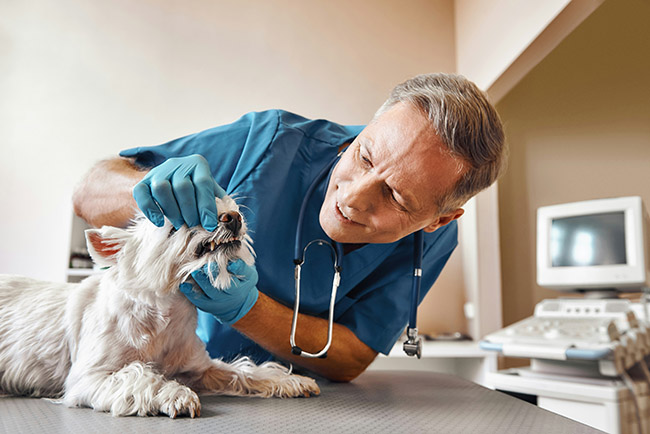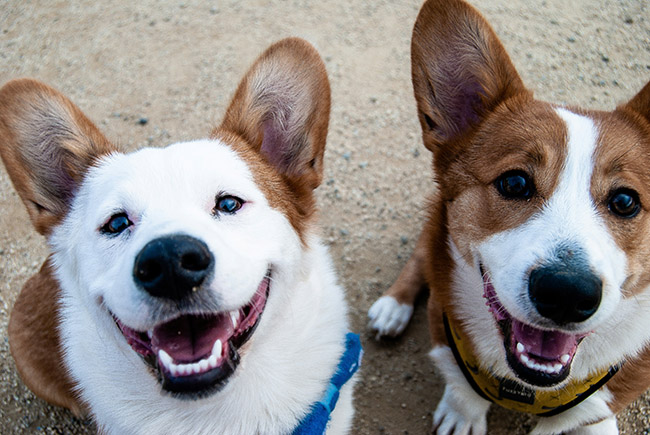Nothing ruins a beautiful snuggle with your dog more than the sometimes overpowering stench of their breath. Bad breath in dogs cannot only disturb those special moments but can also indicate something a little more sinister. Hold onto your nose—Pet Insurance Australia has worked hard to discover our dogs’ stinky breath problems. From when you should be concerned about your pet’s breath to how you can help your beloved canine companion naturally, to even a homemade dog toothpaste recipe!
Bad breath in dogs, also known as halitosis, can be caused by various factors. Similar to those two-legged varieties – AKA humans – the most common reason is poor oral hygiene, which leads to plaque and tartar buildup. When bacteria accumulate in your dog’s mouth, they produce odours that result in bad breath. Other causes, such as dietary habits, gastrointestinal issues, or severe underlying health conditions, can also lead to your pooch having seriously stinky breath. Understanding these causes can help you take the necessary steps to prevent or address bad breath in your dog.
The First Step in Curing Bad Breath in Dogs
The most crucial step regarding your dog’s offensive breath is to book in with your local vet for a good check-up. Bad breath can be a symptom of other issues (see below), and the earlier you can have a diagnosis, the better the outcome for you and your pet.
It’s important to remember that your beloved dog could also be in pain, particularly if any damaged teeth or gums are involved. A sudden onset of rancid breath is a cause for concern and should be checked by your local veterinarian. Teeth and gums are the gateway to the body, and neglecting the health of your dog’s mouth can have serious consequences.
Poor dental hygiene can lead to the buildup of plaque and tartar, which harbour harmful bacteria. These bacteria can enter the bloodstream through inflamed or bleeding gums, potentially causing infections and diseases in vital organs such as the heart, liver, and kidneys. This information is not meant to scare you, but to emphasise the importance of your role in maintaining your pet’s oral hygiene and health.
However, if your dog just needed a good old scrub with a professional veterinary toothbrush, there are some great ways to ensure that the odorous ponk does not return.
How Can I Get Rid of My Dog’s Bad Breath?
-
Regular Brushing
Just like with humans, brushing is the number one way to ensure your pet’s gums and teeth are kept in top condition. By using a dog-specific toothbrush and toothpaste, you can remove plaque and bacteria, and also keep tabs on if anything else is occurring in the body. If your pet suddenly starts to exhibit smelly breath, you know that there could be another underlying condition that needs veterinary treatment. Your role in this is crucial, as you are the one who can detect these changes early on and take the necessary steps to ensure your pet’s health.
-
Healthy Diet
Dogs need a well-balanced and species-correct diet. Feeding too much human food, foods rich in fats, or other components that dogs do not need can cause bad breath. A diet that is specifically balanced and species-correct can help prevent bad breath.
-
Chew Toys and Dental Treats
Toys are not only great at beating boredom, specially designed dental toys can also help their oral health. By providing dental chews and toys that help clean teeth and reduce plaque buildup in between brushes.
-
Hydration
Keep your dog hydrated all year round. Fresh water can help wash away food particles and bacteria in the mouth. Hydration is essential for promoting saliva production, preventing dry mouth, and washing away food debris. This can help prevent the buildup of bacteria and food particles that can cause bad breath.
-
Natural Remedies
Add natural breath fresheners like parsley, coconut oil, and apple cider vinegar to your dog’s diet. See below for some top natural remedies for bad breath in dogs.
Can Bad Breath Be a Symptom of Something Else in Dogs?

Yes, persistent bad breath can be a symptom of more severe health issues. This is why it is vital to have a good veterinary check to ensure your pet is clear of any underlying conditions before self-treating it. Treating bad breath without a proper diagnosis can potentially worsen the condition or mask more serious health issues, so it’s always best to consult a professional.
These can include:
- Periodontal Disease: This advanced gum disease can lead to severe bad breath and other health issues.
- Diabetes: A sweet or fruity smell can indicate diabetes in dogs.
- Kidney Disease: A urine-like odour can be a sign of kidney issues in dogs. Some owners have also noted that it smells fishy or has an ammonia undertone.
- Liver Disease: A foul metallic-like odour accompanied by vomiting and a yellow tinge to the gums can indicate liver disease.
- Oral Health Issues: A rotten and consistent foul smell can indicate oral issues in dogs.
Should I Be Worried If My Dog Has Bad Breath?
If your dog has persistent bad breath, it’s essential to consult a veterinarian. While some cases of bad breath can be managed with improved oral hygiene and diet, others may indicate serious health issues that require medical attention. As with all medical conditions, the sooner you treat the problem and have a solid diagnosis, the better for your pet’s overall well-being and health.
Bad breath in dogs is a common issue that can often be managed with good oral hygiene and a healthy diet. Always consult your vet before trying new remedies to alleviate your dog’s bad breath.
Natural Remedies for Bad Breath in Dogs

Bad breath in dogs, also known as halitosis, can be unpleasant and may indicate underlying health issues. Once you’ve had the all-clear from your vet, you can use some additional natural additives to help prevent the smell from returning.
Here are some natural remedies to help cure your dog’s bad breath:
Add a small amount of fresh parsley to your dog’s food. Parsley is a natural breath freshener and is safe for dogs in small quantities.
Offer carrots and apple slices as treats. These crunchy fruits and vegetables can help clean your dog’s teeth and freshen their breath.
Mix a small amount of coconut oil into your dog’s food or use it to brush their teeth. Coconut oil has antimicrobial properties that can help reduce the bacteria causing bad breath.
Add probiotics to your dog’s diet through supplements or probiotic-rich foods like yogurt (ensure it’s dog-safe and plain without added sugar). Probiotics can improve gut health, which in turn can help reduce bad breath.
Add a teaspoon of apple cider vinegar to your dog’s water bowl. Apple cider vinegar can help balance the pH levels in your dog’s mouth, reducing bad breath. However, due to the difference in taste, it’s essential to ensure your dog continues drinking the water, so always check that your canine companion is still drinking enough.
Can You Make Homemade Dog Toothpaste?
It is crucial to remember that dogs should not use human-grade toothpaste. This toothpaste can have many additives that are highly toxic to dogs. The great news is that you can easily make your own if you are short on doggy-friendly toothpaste! Using dog-specific toothpaste is crucial because it does not contain harmful additives or ingredients that are unsafe for dogs, such as Xylitol.
Creating a natural toothpaste for your dog is a great way to maintain their dental health without exposing them to potentially harmful chemicals. Here’s a step-by-step guide to making dog toothpaste using simple, natural ingredients.
Ingredients
– 1/4 cup of coconut oil
– 1/4 teaspoon of turmeric powder
– 1/4 teaspoon of kelp/seaweed powder
– 1 tablespoon of baking soda
– A few drops of peppermint essential oil (ensure it’s safe for dogs), fresh parsley, or fresh mint leaves.
Instructions
- Gather Your Ingredients
Make sure you have all the ingredients ready. Coconut oil is a natural base known for its antibacterial properties. Turmeric powder is excellent for reducing inflammation and promoting oral health. Kelp powder helps reduce plaque buildup, and baking soda is a mild abrasive that helps clean the teeth. Peppermint oil freshens breath but should be used sparingly to ensure it is safe for your dog. If you cannot find dog-safe peppermint oil, try adding a few mint leaves or a sprinkle of parsley to the mix.
- Melt the Coconut Oil
If your coconut oil is solid, melt it slightly in a microwave or over a stovetop until it becomes a liquid. This will make it easier to mix with other ingredients.
- Mix the Dry Ingredients
Combine the turmeric powder, kelp powder, and baking soda in a small bowl. Stir these ingredients together until they are well mixed.
- Combine with Coconut Oil
Gradually add the dry mixture to the melted coconut oil. Stir continuously to ensure that all the ingredients are well incorporated.
- Add Some Freshness
Add a few drops of the dog-friendly peppermint essential oil to the mixture. This will help freshen your dog’s breath. Be careful not to add too much, as essential oils are potent. You can also use some pulverised parsley or mint leaves. Just remember less is best so you do not put your dog off the taste.
- Blend Until Smooth
Stir the mixture thoroughly until it reaches a smooth, paste-like consistency. If the mixture is too thick, you can add a bit more melted coconut oil. If it’s too thin, add a bit more baking soda.
- Store Properly
Transfer the toothpaste to an airtight container. Store it in a cool, dry place or in the refrigerator to keep the coconut oil from liquefying too much.
How to Use Dog Toothpaste
Getting your pup used to having their teeth cleaned is a great way to ensure this task is easy throughout their lives. However, it is never too late. For older dogs, the process will take a little longer to perfect. Just take it super slow and listen to your dog’s cues so they do not fear the toothbrush. Plenty of pats and love help hugely during this process to ensure it is a positive event for your dog.
- Introduce Gradually: First, let your dog taste a small amount of the toothpaste to ensure they like the flavour.
- Apply to Toothbrush: Use a dog-specific toothbrush or a finger brush. Apply a small amount of the toothpaste.
- Brush Gently: Lift your dog’s lips and gently brush their teeth in a circular motion, paying particular attention to the gum line.
- Rinse if Necessary: While dogs typically don’t need to rinse their mouths, you can offer them a drink of water after brushing.
Tips For Dog Teeth Cleaning
Aim to brush your dog’s teeth several times weekly, as consistency is key. Regular brushing helps reduce plaque buildup and maintain oral health. Always keep an eye on your dog’s reaction. If they show any signs of discomfort or allergic reactions, discontinue use and consult your vet.
By making your own natural dog toothpaste, you can ensure that your pet’s dental care is free from harmful chemicals and tailored to their specific needs. Regular use can significantly improve your dog’s oral hygiene and overall health.
Happy doggy smiles pet lovers!
Key Takeaways:
- Understand the Causes: Bad breath in dogs, or halitosis, can stem from various factors including poor oral hygiene, dietary habits, gastrointestinal issues, or underlying health conditions.
- Consult a Vet: Persistent bad breath should prompt a veterinary check-up to rule out serious health issues like periodontal disease, diabetes, kidney disease, liver disease, or oral health issues.
- Maintain Oral Hygiene: Regular brushing with dog-specific toothpaste, offering a well-balanced diet, providing dental chews and toys, and ensuring hydration are crucial for preventing bad breath and maintaining oral health.
- Natural Remedies: Incorporating natural breath fresheners like parsley, carrots, apples, coconut oil, probiotics, and apple cider vinegar into your dog’s diet can help alleviate bad breath.
- Homemade Dog Toothpaste: You can make your own dog toothpaste using natural ingredients like coconut oil, turmeric powder, kelp/seaweed powder, baking soda, and dog-friendly essential oils. Regular brushing with this toothpaste can promote oral hygiene without exposing your pet to harmful chemicals.
- Proper Usage: Introduce tooth brushing gradually, use a dog-specific toothbrush or finger brush, brush gently in circular motions focusing on the gum line, and rinse with water if necessary. Consistency is key for effective dental care.
By understanding the causes of bad breath, consulting a vet for proper diagnosis, maintaining good oral hygiene, incorporating natural remedies, and using homemade dog toothpaste, you can ensure your pet’s dental health and overall well-being.
Post Views: 5

Nadia Crighton is a renowned and accomplished professional in the fields of Journalism, Public Relations, and Writing, with an extensive career spanning over 25 years, 20 of which have been dedicated to promoting the health and well-being of pets.


